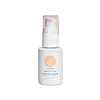What's inside
What's inside
 Key Ingredients
Key Ingredients

 Benefits
Benefits

 Concerns
Concerns

No concerns
 Ingredients Side-by-side
Ingredients Side-by-side

Water
Skin ConditioningAloe Barbadensis Leaf Juice
Skin ConditioningSodium Ascorbyl Phosphate
AntioxidantPalmitoyl Pentapeptide-4
Skin ConditioningSodium Hyaluronate
HumectantBeta-Glucan
Skin ConditioningGlycosphingolipids
EmollientChamomilla Recutita Extract
Skin ConditioningCamellia Sinensis Leaf Extract
AntimicrobialOlea Europaea Leaf Extract
PerfumingCarbomer
Emulsion StabilisingArginine
MaskingCaprylyl Glyceryl Ether
CleansingCaprylhydroxamic Acid
Propanediol
SolventWater, Aloe Barbadensis Leaf Juice, Sodium Ascorbyl Phosphate, Palmitoyl Pentapeptide-4, Sodium Hyaluronate, Beta-Glucan, Glycosphingolipids, Chamomilla Recutita Extract, Camellia Sinensis Leaf Extract, Olea Europaea Leaf Extract, Carbomer, Arginine, Caprylyl Glyceryl Ether, Caprylhydroxamic Acid, Propanediol
Water
Skin ConditioningLeuconostoc/Radish Root Ferment Filtrate
AntimicrobialPropanediol
SolventAscorbic Acid
AntioxidantGlycerin
HumectantChamomilla Vulgaris Extract
Skin ProtectingXanthan Gum
EmulsifyingLecithin
EmollientSclerotium Gum
Emulsion StabilisingPullulan
Honey
HumectantCamellia Sinensis Leaf Extract
AntimicrobialPisum Sativum Extract
Skin ConditioningAlgae
Skin ConditioningPhospholipids
Skin ConditioningSphingolipids
EmollientHyaluronic Acid
HumectantIngredients Explained
These ingredients are found in both products.
Ingredients higher up in an ingredient list are typically present in a larger amount.
Camellia Sinensis Leaf Extract is derived from the leaves of the tea plant. Black tea, green tea, and oolong tea are all harvested from this plant.
This ingredient has many skin benefits:
This ingredient contains polyphenols, a strong antioxidant. Antioxidants help fight off molecules that damage skin cells.
On top of that, the antioxidants in green tea neutralize free-radicals from the sun. This gives the skin some extra UV protection, but should not replace sunscreen.
Many components of tea have anti-inflammatory properties.
Polyphenols and L-theanine help soothe the skin and reduce irritation. The caffeine in Camellia Sinensis Leaf Extract helps calm inflamed blood vessels.
Other compounds found in tea include: Vitamin Bs, linoleic acid, magnesium, calcium, iron, and zinc.
Research has shown both drinking Camellia Sinensis Leaf Tea and applying it to the skin can help boost skin elasticity and hydration. Studies also show using tea extract may reduce sebum, or oil, production.
Learn more about Camellia Sinensis Leaf ExtractPropanediol is an all-star ingredient. It softens, hydrates, and smooths the skin.
It’s often used to:
Propanediol is not likely to cause sensitivity and considered safe to use. It is derived from corn or petroleum with a clear color and no scent.
Learn more about PropanediolWater. It's the most common cosmetic ingredient of all. You'll usually see it at the top of ingredient lists, meaning that it makes up the largest part of the product.
So why is it so popular? Water most often acts as a solvent - this means that it helps dissolve other ingredients into the formulation.
You'll also recognize water as that liquid we all need to stay alive. If you see this, drink a glass of water. Stay hydrated!
Learn more about Water